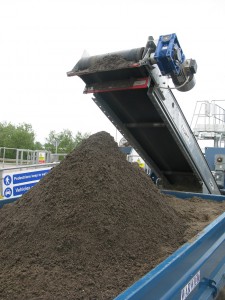According to Siltbuster, leading waste treatment specialists, the newly published revised edition of the Waste and Resources Action Programme (WRAP) Protocol on the recovery of Aggregates from Waste is a major development for local authorities and their waste management companies, as it means they can now recycle the bulk of their gully or sweeper waste.
The recent announcement by WRAP, states that the mineral fraction recovered by Mechanical and/or Biological Treatment (MBT) can now be used as feed stock for aggregate recycling, therefore allowing recovered material to be removed from the waste chain for the first time and achieve ‘End of Waste Status’.
Prior to this, the recycling of aggregate from sweeper or gully waste could only been undertaken by a limited number of sites holding a bespoke Environmental Permit. As such it was out of the reach of most local authorities.
Although in volume terms, gully or sweeper waste is small compared to domestic waste, it represents a significant proportion of the overall weight of waste local authorities have to deal with. In addition to this, since April’s increase in the Landfill Tax, simply sending gully waste to landfill is a much more expensive proposition than it used to be. Therefore it is a valuable recycling opportunity for local authorities trying to meet ambitious recycling targets and minimise costs; typically gully or sweeper waste contains 60% to 80% mineral fraction which if reprocessed could be put to good reuse, leaving only the organic and finer fractions for disposal or further treatment.
Dr Richard Coulton CEO of Siltbuster Ltd says: “To date most local authorities have managed to meet their recycling targets by maximising recovery from domestic waste. But with stiff targets still to meet, and most of the obvious avenues exhausted, they need to find new options. This development is therefore a golden opportunity for local authorities as it makes recycling of gully and sweeper waste a viable option.”
According to the revised protocol from WRAP the MBT process must be designed to recover the mineral as a clean product free from the organics and other contaminants. Simply screening the material without further treatment will not achieve the required separation; the material must be put through a washing system, such as Siltbuster’s Gritbuster, specifically designed to separate the components on both size and density. Following separation the material can then be further processed under the WRAP protocol and sold as aggregate.
Richard Coulton concludes: “With over one million tonnes of roadside and gully waste to be dealt with each year nationally, there has never been a better moment for local authorities to revisit how they deal with their road and gully waste.”
A Closer Look at How the Guidance has Changed: The Guidance on the “Recovery of Street Sweepings and Gully Emptyings” published by the Environment Agency in May 2012 importantly sets out the framework for handling these materials. The guidance confirmed that following physical (mechanical) and/or biological treatment (MBT) the waste would be reclassified from waste code 20-03-03 (Street Cleansing Residues) to a Chapter 19 code (Mechanical and/or Biological Treated waste – MBT). It also stated that after physical/biological treatment street sweeping and gully emptyings could potentially be recovered as soil substitute and/or aggregate; which, on the face of it, opened the door to recycling at least the mineral fraction found in sweeper/gully waste. However the guidance then all but closed the door again by stating that the material could not be reprocessed under the previous edition of WRAP Protocol and that each site would need to apply individually for End of Waste status.
As a result the recycling of aggregate sourced from sweeper/gully waste has only been undertaken by a limited number of sites with a site specific Environment Agency approved End of Waste Protocol. Leaving the possibility of recycling sweeper/gully water out of reach of most local authorities …until now.
To achieve End of Waste Status the mineral fraction must first be recovered from the sweeper/gully waste by MBT and then reprocessed in accordance with the WRAP Protocol. At that point the material becomes a usage aggregate product and provided it is put to beneficial re-use is no longer considered a waste.
Set up and run by experienced process engineers, Siltbuster Ltd. also provides an unrivalled range of technologies and practical solutions for the construction & environmental remediation industry to deal with all aspects of silt management and waterborne pollution prevention or control. Siltbuster Process Solutions Limited, a sister company to Siltbuster Limited, provides water and effluent treatment solutions for the industrial manufacturing, food and drinks production, municipal waste water, potable water, agriculture and minewater discharges.
To find out more about Gritbuster call George Anderson on 01600 772256 or visit www.siltbuster.com







Recent Comments